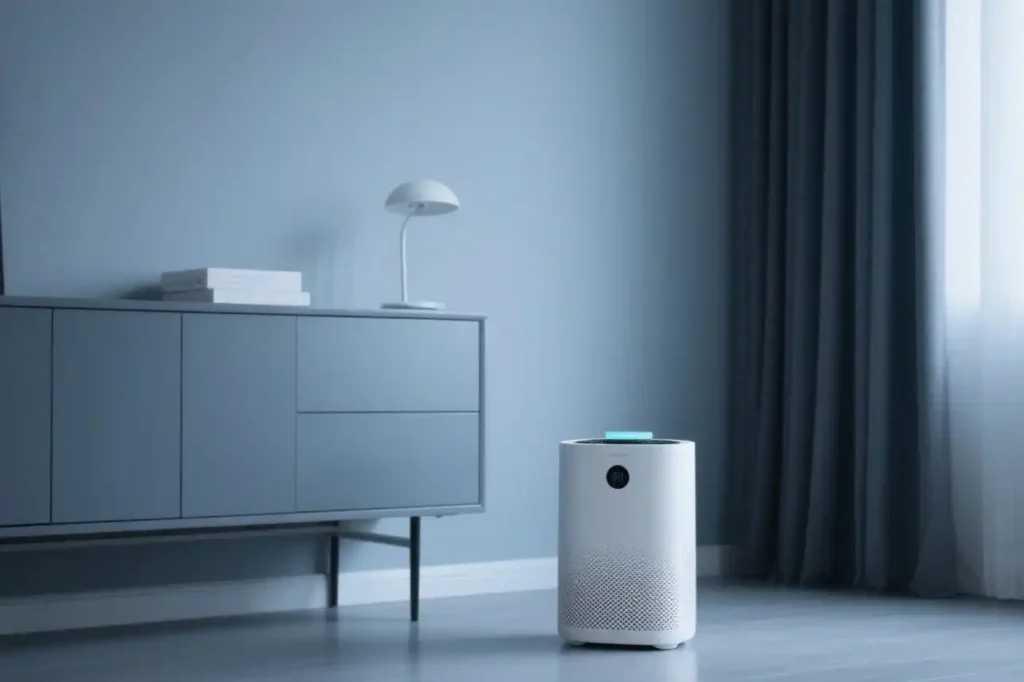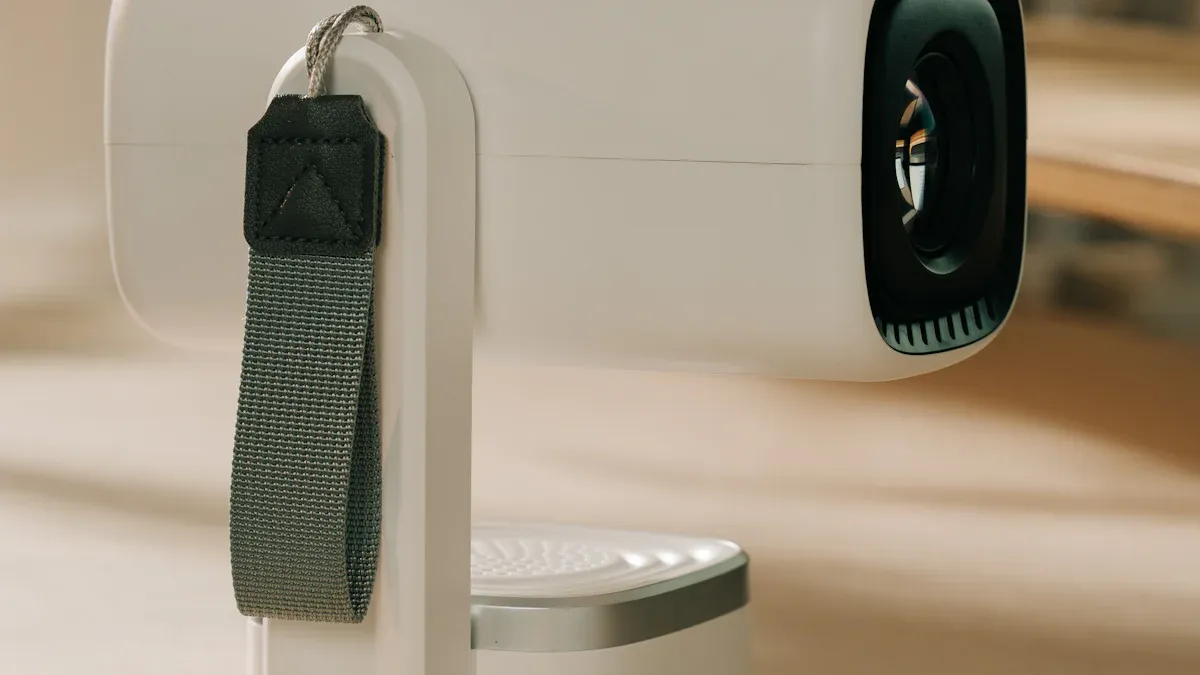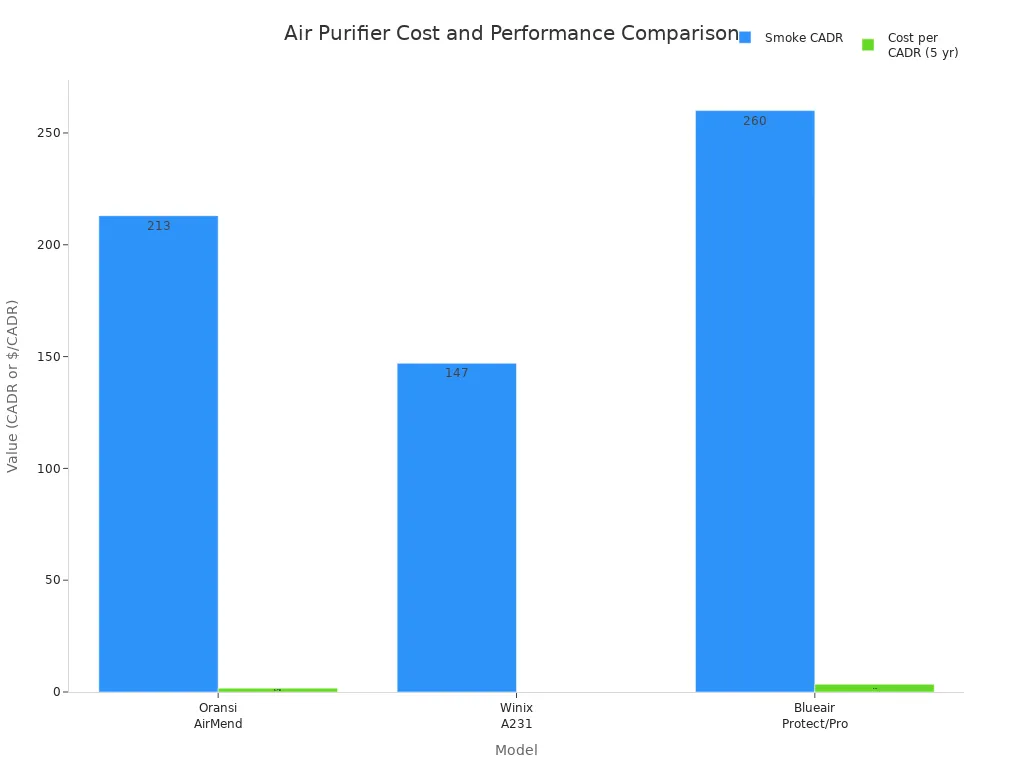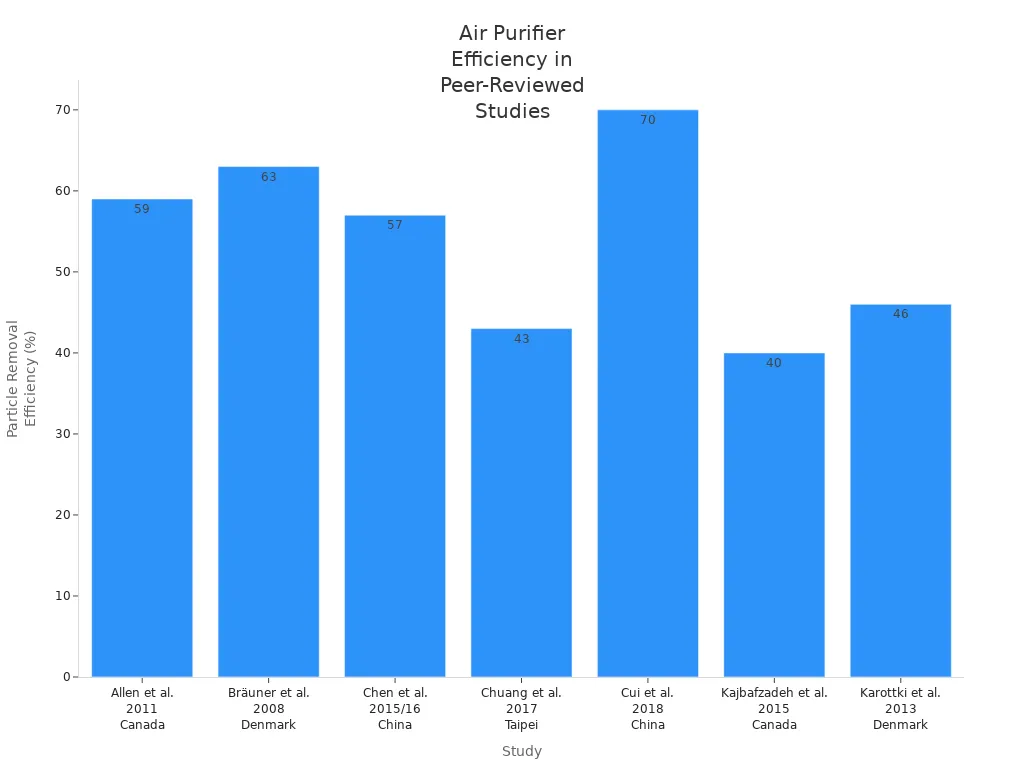
Many people ask if an air purifier can help indoor air. Some ads say it will clean air very fast. Other stories say these devices do not work. People get confused because companies use many words and claims. People want to know what is true before they buy one. Science and experts can help answer these questions.
Key Takeaways
- Air purifiers do not all work the same way. You should check the filter type and the Clean Air Delivery Rate (CADR) before you buy one. HEPA filters are good at catching tiny particles. Activated carbon filters help get rid of smells and gases. Stay away from air purifiers that make ozone. Ozone can hurt your lungs and cause health issues. Make sure the air purifier’s CADR matches your room size. Put it in an open spot for the best results. Buy from sellers you trust. Look for real certifications. Be careful of fake claims or very cheap deals.
Air Purifier Myths

All Are the Same
Some people think all air purifiers work the same. This idea is wrong.
- Some use HEPA filters, but others use ionizers or carbon filters.
- Devices with a higher Clean Air Delivery Rate (CADR) clean air faster and better.
- HEPA filters trap particles, but ionizers work in another way and can put ions in the air.
- Some purifiers are good for small rooms, but others work for big spaces.
Tip: Always look at the CADR and filter type before you buy an air purifier. Not every device works the same.
Remove All Pollutants
No air purifier can get rid of every pollutant. How well they work depends on the filter and technology.
| Pollutant Type | Removal Effectiveness | Notes |
|---|---|---|
| Particulate Matter (PM2.5) | Most effective | Includes dust, pollen, smoke |
| Gaseous Pollutants (VOCs, CO) | Least effective | Needs activated carbon; standard filters do not work |
| Odors | Least effective | Requires carbon filters |
| Ozone Generators | Not effective | Can be harmful |
Some things, like carbon monoxide and radon, cannot be removed by normal filters. Activated carbon filters help with gases and smells, but not every purifier has them.
Eliminate Viruses
Some ads say air purifiers can get rid of viruses. Studies show HEPA filters can lower virus particles in the air, but it depends on room size, where you put the purifier, and how much air moves.
- Purifiers can help stop viruses from spreading, but they do not remove all viruses.
- Using fresh air and other safety steps with purifiers works best.
Whole House Coverage
Some people think one air purifier can clean a whole house. Most purifiers are made for just one room, not the whole house.
- Each purifier shows how much space it can clean, usually in square feet.
- For big homes, you need more than one unit or a system with the HVAC.
Note: Always match the purifier’s CADR to the room size for the best results.
Price Equals Quality
Some people believe a higher price means better air cleaning. Tests show this is not always true.
- Some cheaper models clean air as well as expensive ones.
- How well a purifier works depends on CADR, filter type, and room size, not just price.
- The cost to run the purifier, like buying new filters, also matters.
Remember: Look at how well the purifier works, not just the price.
Capabilities
HEPA Filters
HEPA filters are very good at cleaning indoor air. They can catch almost all tiny particles, even ones you cannot see. This means they trap dust, pollen, smoke, bacteria, and some viruses. HEPA filters use different ways to catch these things, like making them stick or slow down. Hospitals and cleanrooms use HEPA filters to keep air safe. The CDC says to use HEPA filters with pre-filters in hospitals to help stop diseases from spreading.
- HEPA filters work best if you put them in right and take care of them.
- Pre-filters grab bigger stuff first, so the HEPA filter lasts longer.
- Over time, HEPA filters fill up and block more air. You need to change them often to keep them working.
- How well a HEPA filter works depends on the system and if it fits the room.
Note: Always check if the filter is certified and change it when the maker says.
Carbon Filters
Activated carbon filters help with gases and smells that HEPA filters miss. These filters have special carbon with lots of tiny holes. The holes trap VOCs and bad smells from things like smoke, paint, and cleaners. Lab tests show carbon filters can remove a lot of VOCs, but it depends on the gas and the filter. Some carbon filters can even get rid of ozone.
But carbon filters cannot do everything. How well they work depends on how much carbon is inside, how fast air moves, and how often you change the filter. When a carbon filter is full, it cannot trap more gas and might let some out. For best results, change carbon filters often and make sure there is enough carbon for your room.
UV and Ionic Types
UV air purifiers use special light to kill germs and some viruses. If you use them with HEPA filters, they can lower germs in the air. But UV purifiers do not clean dust, pollen, or VOCs. Some UV machines can make ozone if they are not made right, and ozone is bad for you.
Ionic air purifiers send out charged particles called ions. These ions stick to things in the air and make them fall down. Studies show ionic purifiers are not great at catching tiny particles like PM2.5. They can also make bad stuff like ozone and formaldehyde. Some research says negative ions can hurt your health and cause stress or heart problems.
| Technology | Particle Removal | Odor Control | Microbe Control | Ozone Production | Safety Rating |
|---|---|---|---|---|---|
| HEPA Filter | Excellent | Poor | Good | None | ★★★★★ |
| Activated Carbon | Poor | Excellent | Poor | None | ★★★★★ |
| UV-C (Ozone-free) | Poor | Poor | Excellent | None | ★★★★★ |
| Ionic/Ionizer | Fair | Fair | Fair | Often High | ★★☆☆☆ |
| Ozone Generator | Poor | Good | Good | Very High | ★☆☆☆☆ |
| Natural Methods | Poor | Fair | Poor | None | ★★★★★ |
Tip: Experts say to use HEPA and carbon filters at home. Do not use ionic purifiers if kids or people with lung problems live there.
Ozone Risks
Ozone air purifiers say they can clean air and kill germs. But ozone is a harmful gas that can hurt your lungs. The EPA and World Health Organization warn that ozone can make you cough, hurt your throat, and make asthma worse. Too much ozone can damage your lungs and make you sick. Even a little ozone does not clean indoor air well.
| Aspect | Details |
|---|---|
| Health Risks | Ozone can make it hard to breathe, cause coughing, chest pain, and make asthma worse. It can also hurt your lungs and make you get sick more easily. |
| Regulatory Standards | FDA says no more than 0.05 ppm; OSHA says 0.10 ppm for 8 hours; EPA says 0.08 ppm for 8 hours outside. |
| Additional Findings | Ozone machines can go over safe limits, especially in small rooms or if you use more than one. Ozone can also mix with air and make other bad chemicals. |
| Recommendations | Use HEPA and carbon filters instead. Do not use ozone machines to clean air. |
Warning: Ozone is not safe for cleaning air inside. Pick safer ways to clean your home’s air.
Placement and Room Size
How well an air purifier works depends on where you put it and how big the room is. Studies show that putting a purifier in the middle of the room helps it clean better. Every purifier has a CADR number that matches a room size. If the room is too big, the purifier will not work as well.
| Room Size | Recommended CADR Range | Air Changes Per Hour |
|---|---|---|
| Small (up to 200 sq ft) | 100-200 | 4-5 |
| Medium (200-400 sq ft) | 200-300 | 3-4 |
| Large (400-600 sq ft) | 300+ | 2-3 |
- Leave 3-5 feet of space around the purifier.
- Do not put purifiers in corners or behind things.
- For big rooms, use stronger purifiers or more than one.
- Put purifiers near things that make pollution, like kitchens or carpets, for better cleaning.
Note: Always pick a purifier with the right CADR for your room to get the best results.
Air Purifier Scams

False Claims
Some companies do not tell the truth about their products. They might say their air purifiers clean air perfectly or remove every pollutant. Groups that check products have found some devices only have fans and no real filters. These machines do not clean the air like they promise. Some companies also say their air purifiers kill viruses or make you healthier. These claims can trick people and may be dangerous, especially when pollution is high. Groups like the Bureau of Indian Standards now check air purifiers more often. They may soon make strict rules to keep people safe. The Central Consumer Protection Authority can punish companies that lie, even with big lawsuits.
Tip: If a company says its product removes all pollutants or cures health problems, be careful. Real air purifiers cannot do everything.
Fake Certifications
Some air purifiers show fake or useless certifications. Real certifications come from trusted groups and prove a device is safe and works well. Buyers should look for these real certifications:
- AHAM Verifide®: Shows the purifier was tested for Clean Air Delivery Rate (CADR).
- CARB: Means the device meets California’s ozone rules.
- UL Safety Testing: Checks for fire and electrical safety.
- FCC Compliance: Makes sure the device does not cause bad signals.
- DOE Testing: Tests how much energy the device uses.
- Energy Star: Means the device saves energy.
| Certification | Purpose | Testing/Certifying Body |
|---|---|---|
| UL Safety Testing | Electrical and fire safety | UL, Intertek, TUV, SGS |
| FCC Compliance | Electromagnetic standards | Federal Communications Commission (FCC) |
| CARB Registration | Low ozone emissions | California Air Resources Board (CARB) |
| DOE Testing | Energy efficiency | Department of Energy (DOE) |
| AHAM Verification | CADR performance | Association of Home Appliance Manufacturers (AHAM) |
| Energy Star | Energy efficiency | Environmental Protection Agency (EPA) |
People can check for real labels on the box or product. They can also use websites, like the UL database, to see if a model is certified. Asking the seller for lab reports or certification papers helps too.
Note: If a product has no real certification or uses fake logos, it may not be safe or work well.
Ozone Dangers
Some air purifiers use ozone to clean air. Ozone can hurt your lungs and make it hard to breathe. The California Air Resources Board (CARB) has strict rules for ozone. Devices must not release more than 0.050 parts per million of ozone. CARB tells people not to use ozone generators in rooms where people or pets stay. Ozone can cause coughing, chest pain, and make asthma worse. It can also mix with other chemicals and make new, harmful pollutants.
Federal groups do not fully control ozone machines. The EPA calls ozone generators pesticide devices but does not check them often. The FDA only controls devices that say they help with health. The CDC and CARB both say to use HEPA filters instead of ozone machines. They also warn that some companies use tricky ads to sell ozone devices.
- Ozone can cause coughing, chest pain, and trouble breathing.
- Ozone can make asthma and other lung problems worse.
- Ozone generators are not allowed in rooms with people or animals.
Warning: Do not use any air purifier that makes ozone. Pick safer choices with HEPA and carbon filters.
Overpriced Models
Some air purifiers cost a lot but do not work better. Cheaper models like the Winix A231, which costs less than $100, can clean air well and have HEPA and carbon filters. Expensive models, like the Blueair Protect 7470i, can cost over $600 but may not clean air much better. The cost for each unit of air cleaning (cost per CADR) is often higher for these pricey models. Many expensive purifiers do not have extra features to match the price.
| Model / Price Range | Smoke CADR | Initial Cost Range | 5-Year Total Cost Range | Cost per CADR (5 yr) | Notes |
|---|---|---|---|---|---|
| Oransi AirMend Series | 189-237 | $180 – $240 | $318 – $423 | ~$1.68 – $1.78 | Effective, good CADR, reasonable filter costs |
| Budget Model: Winix A231 | 147 | Under $100 | N/A (filters affordable) | N/A | Strong performance, multi-stage filtration |
| Overpriced Models (Blueair Protect 7470i, Blueair Pro M) | 250-270 | $280 – $600+ | Over $1,100 | $2.22 – $4.72 | Higher cost per CADR, less cost efficient |

Cheaper models can clean air well and save money. A high price does not always mean better cleaning.
Scam Warning Signs
Groups that protect buyers have found many scam signs. Watch out for these red flags:
- Claims that a device removes gases but has no carbon filter.
- Ozone generators called safe or healthy.
- Off-brand or cheap replacement filters that do not work well.
- Prices much lower than other similar models.
- Devices sold by unknown sellers or pyramid schemes.
- Products with no real certifications or fake logos.
- Ads that promise to kill all viruses or guarantee better health.
Some scams use tricky ads for “ionic” or “electronic” air cleaners. Some devices, like the EcoQuest air cleaner, have caused asthma attacks and breathing problems. The Ionic Breeze by Sharper Image was sued for false ads and ozone risks. The Oreck XL air cleaner lost power as it filled with dust and needed lots of cleaning.
Tip: Always check the product, look at the filter type, and buy from trusted sellers. If a deal seems too good to be true, it probably is.
Checklist for Safe Purchasing:
- Look for real certifications (AHAM, CARB, UL, Energy Star).
- Read reviews from trusted places.
- Check the filter type and CADR rating.
- Do not buy ozone generators.
- Buy from official dealers.
- Ask for certification papers if you are not sure.
Choosing an Air Purifier
Key Features
When you pick an air purifier, look for features that help it work well and make it easy to use. Experts say these things are important:
- HEPA filters can catch almost all tiny things in the air, like dust, pollen, and mold.
- Activated carbon filters help get rid of bad smells and trap gases such as VOCs.
- Noise level is important if you want to use the purifier in a bedroom or office. Quiet purifiers help you sleep or work better.
- Airflow rate tells you how fast the purifier can clean the air in a room. A higher number means the air gets cleaned faster.
- Energy-saving purifiers, like ones with Energy Star, use less power and save money.
- Some purifiers have automatic settings that change the speed when the air gets dirty. This makes them easier to use.
- A good warranty and a clear return policy help protect your money if something goes wrong.
- Think about the total cost, including new filters and taking care of the purifier.
Tip: Always choose a purifier with a CADR that matches your room size for the best cleaning.
Verifying Claims
Not every company tells the truth about their air purifiers. Buyers should check if the company has test results from other groups. Certifications from groups like AHAM or Asthma & Allergy Friendly® mean the purifier meets tough rules. You can also read reviews and stories from people who have used the purifier. Good companies share lab results and explain how their purifiers work. They also answer questions about safety and how well the purifier works.
Here is a simple checklist to check if claims are true:
- Look for certifications and test results from other groups.
- Read what customers say for honest opinions.
- Check details like CADR and how loud the purifier is.
- Stay away from brands that make big promises but do not show proof.
Where to Buy
Buy your air purifier from sellers you trust to avoid scams. Official brand websites, big electronics stores, and trusted online shops are safe places to buy. These sellers give real warranties and help if you have problems. Do not buy from websites you do not know or deals that look too good to be true. Always check for real certifications and ask for proof if you are not sure.
Note: Buying from trusted places helps make sure you get a good product and help if you need it.
Benefits and Limits
Allergy Relief
Many people with allergies want help from air cleaners. Studies over 40 years show HEPA filters can help a little. Researchers saw small but real improvements in symptoms and sleep for people with asthma and allergic rhinitis.
- Some trials show HEPA filters lower allergens in the air, like cat dander.
- A review of ten studies found better symptoms and less sleep trouble, but nose symptoms and medicine use did not change much.
- HEPA filters can cut indoor particles by 30% to 70%. This may mean fewer asthma attacks.
- One study in South Korea showed people used 26% less allergy medicine with HEPA filters.
- HEPA filters work best if you use them all the time, especially in bedrooms where dust and allergens build up.
Note: HEPA filters help some allergy symptoms, but they do not remove every allergen.
Odor Reduction
HEPA filters catch dust and allergens, but not most smells. Reviews show that odors and gases, like VOCs, need a different filter. Activated carbon filters can trap many smells and some gases. In lab tests, air cleaners with both HEPA and activated carbon filters removed smells and ozone from the air.
Regulators warn against ozone generators. These machines do not remove smells well and can make harmful byproducts. People should pick devices with safe filters for odor control.
Air Quality
Researchers have checked how much indoor air gets better after using air cleaners. Many studies found HEPA filters lower PM2.5 by 40% to 82%. This can help heart and lung health for some people. For example, studies in Canada, Denmark, and China showed lower blood pressure, less swelling, and better breathing after using air cleaners.
| Study (Location, Year) | Baseline PM2.5 (μg/m3) | Particle Removal Efficiency (%) | Health Improvements |
|---|---|---|---|
| Allen et al., 2011 (Canada) | 11.2 | 59 | Better blood vessel function, less inflammation |
| Bräuner et al., 2008 (Denmark) | 12.6 | 63 | Improved blood vessel function in elderly |
| Chen et al., 2015/2016 (China) | 96.2 | 57 | Lower blood pressure, less inflammation, better DNA health |
| Chuang et al., 2017 (Taipei) | 21.4 | 43 | Lower blood pressure, less oxidative stress |
| Cui et al., 2018 (China) | 33.2 | 70 | Better lung function, lower risk of blood clots |

Researchers also found air cleaners work best when windows are closed. More units and higher speeds clean the air faster.
Realistic Expectations
Air cleaners help, but they do not fix every problem.
- They cannot remove all pollutants or 100% of any one pollutant.
- They work less well for mold, nicotine, some gases, and big allergens like pollen or dust mites.
- Ionizing air cleaners may make harmful byproducts, like ozone or formaldehyde.
- Experts say people should use air cleaners with other steps, like good airflow and cleaning, for best results.
Tip: Air cleaners make air better and help some symptoms, but they are not a cure-all. People should use them as part of a bigger plan for healthy indoor air.
Readers need to keep some important things in mind when picking devices for cleaner air inside.
- Make sure the device fits your room size and the things you want to clean from the air.
- Pick models that have strong HEPA filters and the right CADR numbers.
- Using more than one filter and choosing quiet machines makes them work better and feel nicer to use.
- Stay away from products that make ozone or do not have real safety labels.
If you make smart choices and check facts, you can avoid scams and get better air at home. Clean air helps everyone feel healthier and more comfortable.
FAQ
How often should someone change air purifier filters?
Most HEPA filters need to be changed every 6 to 12 months. Carbon filters usually need changing every 3 to 6 months. Always read the maker’s guide for the best advice.
Can air purifiers help with pet hair and dander?
Yes, HEPA filters catch pet hair and dander. This can help people with allergies feel better. Put a purifier in rooms where pets spend lots of time.
Do air purifiers make a room completely dust-free?
No, air purifiers lower dust but do not remove it all. You still need to clean and vacuum to get the cleanest air.
Are air purifiers safe for children and pets?
Most purifiers with HEPA or carbon filters are safe for kids and pets. Stay away from ozone generators and ionizers because they can hurt lungs and cause breathing trouble.
Where should someone place an air purifier for best results?
Put the purifier in the middle of the room, not near walls or furniture. Leave space around it so air can move and cleaning works better.
See also
What to Consider Before Putting an Air Purifier in Every Room
How many air purifiers are needed for different room sizes
Uncovering the Truth About Air Purifiers and Their Safety
What Size Air Purifier Is Needed for Bedrooms, Living Rooms, and Offices
